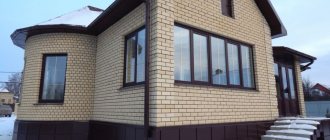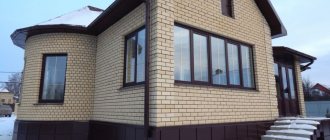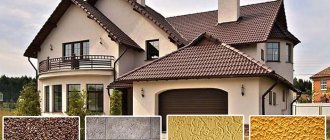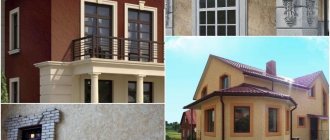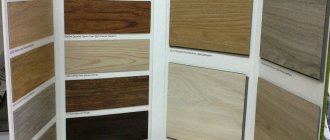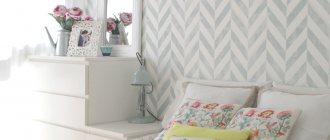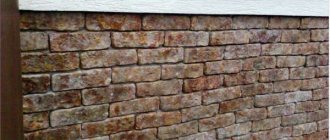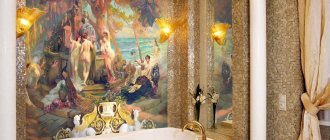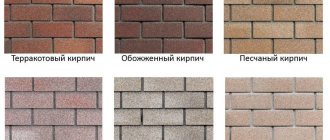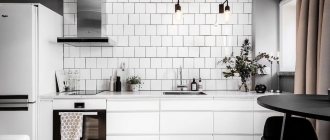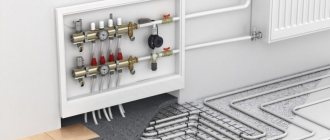Decorating a house includes not only high-quality roofing, but also effective landscaping and reliable protection of the basement of the house and facade.
For facade cladding, various materials are used, which, due to their characteristics, can not only decorate the building, but effectively protect the walls from the influence of environmental factors: rain, snow, sand, mechanical influences.
One of the popular trends in facade design is the use of facade tiles.
The tile is easy to install, it lasts a long time, and does not require special care during operation.
Houses with facing tiles look neat, stylish, and original.
Basic requirements for facade tiles
Buildings are exposed to many adverse effects from their facades - temperature changes, ultraviolet radiation, wind loads, high humidity, and mechanical damage. Therefore, all finishing materials have special requirements:
- mechanical strength;
- resistance to moisture;
- resistance to UV radiation;
- fire safety;
- resistance to chemical influences;
- frost resistance;
- durability;
- ease of care.
In addition, any facade facing tile must comply with environmental standards and also have a beautiful design. The cost of such products varies greatly - from budget to very expensive materials.
Types of facade tiles
There are many options for tiles for finishing facades made from natural and artificial materials. The best tiles for the facade are selected based on color, texture, and properties.
You can combine 2 or several types of facing products, as well as combine them with other surfaces, for example, painted plaster.
Grouting joints
The “wet” method of cladding allows the joints to be grouted 2-3 days after laying the clinker. After the “dry” clinker finishing, the joints can be grouted immediately after installation. A correctly selected contrasting combination of cladding and grout mixture is the key to the aesthetics of the facade, so the color of the grout mixture should not be close to the color of the tiles.
An even more important point is to completely and thoroughly fill the seams and structural joints with a grouting compound to prevent water from flowing under the cladding. It is better to fill the joints of the plinth cladding with compounds based on reactive resins, and the joints on the walls with cement-based mixtures.
An example of a grout mixture for facade clinker is the cement composition Ardex FL, Quick-mix RFS, and for the plinth - Cristallit, Ceresit CM17 and CM117, “Granite” or furan resins.
To fill the joints, a special clinker grout is used, which can be selected by color
High-quality filling of joints is carried out with a construction gun for grouting joints. In this case, the prepared mixture should be quite liquid. In the absence of this tool, you can use a thick plastic bag with a cut off corner, into which the grout solution is added as it is used. The seams are filled flush with the finishing surface, after which they are leveled and compacted with construction jointing. The jointing can be made independently from a metal tube with a diameter of 8-10 mm cut lengthwise.
Contamination with resin-based grout is carried out according to the instructions on the packaging of the grout material. Failure to comply with these rules is fraught with loss of aesthetics of the surface area.
A natural stone
The most expensive and prestigious materials for facade finishing. They have high strength, durability, and other performance characteristics. Because they are so heavy, they require reinforced foundations, strong wall surfaces or strong frames for installation.
Natural stone facade tiles for the home are:
- Granite. Of all natural facing materials, it is particularly durable and weather-resistant. The surface can be matte or polished glossy. Installation requires good professional training.
- Marble. It is distinguished by a variety of colors and natural patterns. Gives the façade a rich, luxurious look. Compared to granite, it is less resistant to weathering because it absorbs moisture due to its porous structure. Therefore, marble surfaces are treated with special protective compounds containing wax. Installation must be carried out by specialists.
- From shell rock. This is a special type of limestone with a porous structure. Shell rock is much cheaper than marble and granite and is widely used for finishing facades and interiors. The unusual texture of such tiles gives the walls freshness and originality. Due to its porosity, the material adheres well to the wall surface. For exterior finishing, you need to choose the densest type of shell rock - grade M35. It is better to carry out installation in warm, clear weather, but not in frost, rain, or heat. To reduce moisture absorption, the tiles are treated with special compounds.
- Made of sandstone. Inexpensive, environmentally friendly material of natural origin. It can be porous or denser. To decorate a house with sandstone facade tiles, you should choose only dense varieties - porous ones will deteriorate over time due to exposure to moisture and temperature changes.
Varieties
The properties of facade tiles will differ depending on the material from which they are made. Its price will also depend on this. The most popular types of tiles include:
- Stone slabs. Looks great in almost any interior and allows you to show the status of the owner. Durable, frost resistant. Service life up to one hundred years. Among the disadvantages, in terms of price, it is not the best region to use such cladding.
- Ceramic tile. Much more affordable compared to the previous type of tile. After finishing, the building looks like brick. The tiles are easier to install, weigh less, and do not absorb moisture at all.
- Concrete tiles. It is practically not inferior to other types in terms of performance characteristics, but at the same time its price is much more attractive.
- Terracotta tiles. Another name for this tile is architectural ceramics. The most environmentally friendly material without chemicals and dyes. Durable, not susceptible to temperature changes, easy to install.
- Porcelain tiles. One of the most favorite materials of designers. Moisture resistant, easy to install.
Agglomerate tiles
It is an artificial stone material obtained from crumbs of spar, granite, quartz, expanded clay with the addition of binders. The mixture is pressed under high temperatures.
In some performance characteristics it surpasses even natural stone. And the cost is much cheaper. Therefore, it is very popular for finishing facades.
A wide variety of design options are available for finishing a house with agglomerate facade tiles. Surfaces come with imitation of various materials, a wide choice of colors. Most often, agglomerate tiles are used to create suspended, ventilated facades.
Note!
Epoxy grout for tiles: pros and cons, scope, varieties, how to work with it (instructions + photos)
Do-it-yourself tile shower tray step by step: instructions, dimensions, design, installation of communications, types of structures, photos
White tiles in the bathroom: 170 photos of the best ideas and new tile designs. Layout schemes and beautiful combinations
About the pros and cons of panels
By following all these settings, you can achieve excellent results in the external insulation of your home and receive undoubted bonuses from this:
- quick and easy installation;
- low thermal conductivity;
- heat saving;
- non-flammability;
- tightness;
- reduction in electricity costs;
- without toxic compounds and any level of danger to human health;
- style and originality on the outside;
- low costs;
- durability of the new façade.
Grouting of joints
Among the disadvantages, experts note the frequent mixing of layers of two-layer slabs due to different densities of the material, so when purchasing, make sure that all panels are homogeneous, otherwise you will have to do additional work after installation - for example, grouting the panels.
Finishing the facade with clinker is outwardly indistinguishable from cobblestone, flat, rocky, burnt stone, wood, brick, metal, etc. - that is, from the decor that you have chosen, such insulating boards give the overall facade an original, expensive look.
Therefore, today you should not overpay for natural stone on the facade - panels with these tiles will completely replace natural components, both visually and practically - their quality is no worse than natural building materials.
Ceramic tile
This type of tile is not much different from the usual one used for interior decoration. But the main thing is that ceramic tiles for external walls must be frost-resistant, otherwise they will quickly crack in the first winter season.
Unlike interior varieties, ceramic facade tiles do not have such a variety of decor. These are mostly plain, dim products, imitating brick or stone.
Porcelain tiles
It is similar to ceramic, only it has higher strength, wear resistance and other performance characteristics. The appearance resembles natural stone.
The composition includes white clay with an admixture of kaolin, quartz, spar, and various additives. Obtained by pressing under high pressure and temperature. Facade tiles are made to look like brick or other materials.
Clinker
Despite the manufacturing technology similar to ceramics, clinker facing tiles for facades have improved characteristics and an almost eternal service life. The high price of clinker is due to energy-intensive production and a limited number of clay deposits. The main characteristics of the material correspond to the following values:
- frost resistance – F200;
- strength – 23MPa (bending);
- moisture absorption – 2%;
- wear resistance – 3 mm/m2.
The heat resistance of clinker is not standardized, since the material is not afraid of extreme temperatures, unattainable even during man-made disasters. Manufacturers produce facade clinker in the following formats:
- “German standard” – 24x7cm;
- “American configuration” – 19.3x5.7 cm;
- European “brick” – 25x12cm;
- non-standard sizes - for example, 44x5.2 cm.
Due to high-temperature firing and strict regulations on third-party additives, the color of clinker is never uniform, even within the same batch. Therefore, after purchasing facade tiles, they are randomly mixed from several boxes before installation. Installation in 90% of cases is carried out using tile adhesive.
Cladding with clinker tiles
Clinker tiles
Clinker façade tiles are made like ceramic tiles from clay, only they contain the slate variety with various additives.
Note!
Italian tiles for floors and walls: photos of beautiful tile designs in the bathroom and kitchen. Choosing tile color, style and size
Marble tiles for the bathroom: TOP-200 photos of original design, ideas for mixing and matching
Do-it-yourself tile shower step by step: instructions, algorithm of actions, dimensions, layout diagrams, photo of a shower with and without a tray
Formed under high pressure from a clay mass, the tiles are fired at high temperatures. The result is a beautiful finishing material that has high resistance to cracking, moisture resistance, and frost resistance.
Concrete tiles
It is obtained by pouring concrete into molds. Cheap available material, large selection of textures and colors. It is quite massive, so you need a solid foundation and strong wall surfaces.
To reduce weight, porous fillers are often added to mixtures. The technology for producing tiles is simple, accessible for self-production.
But it is not recommended to make homemade tiles for wall decoration - factory-made products are of higher quality. Installation is simple, accessible even to beginners. Performance characteristics are average.
Frame mounting
Professional builders prefer another cladding method - installation on a frame. It takes more time, but the results are durable.
The technology used for installation on the frame helps in the construction of ventilation facades. To fix the tiles, a metal frame and metal fasteners are used.
Available components of the façade structure are shown in the diagram. You can use basalt wool instead of mineral wool, as it is less susceptible to shrinkage.
Figure 5. Available components of the façade structure are shown in the diagram.
The installation of a frame system under porcelain tiles is described here.
Polymer sand tiles
They are made from sand, polymers, dyes, and various additives. The mixture is poured into molds and under the influence of high pressure and temperature it becomes very strong. light weight tiles.
It is resistant to moisture, acidic environments, frost-resistant, and is easy to clean from dirt. Refers to the cheapest types of tiles.
Note!
Mosaic from broken tiles: step-by-step instructions on how to lay it out with your own hands (140 photo ideas)
Mosaic for the bathroom: TOP-150 photos of new designs, as well as modern ideas for combining mosaic tiles
Do-it-yourself water heated floor under tiles step by step: installation instructions with photos and descriptions, installation and connection
Terracotta tiles
Made from fired kaolin clay without applying glaze. Completely natural material without chemical additives or dyes. Different shades are obtained by mixing different types of clay. The range of colors ranges from light beige to dark brown.
Terracotta tiles are resistant to low and high temperatures, durable, and easy to install. This cheap material is not inferior in attractiveness to more expensive products.
Flexible bitumen tiles
It belongs to economy class materials, but has a very attractive appearance and good performance characteristics.
The composition of such flexible facade tiles is identical to bituminous shingles. Its base consists of fiberglass and improved bitumen, and a decorative and protective layer of basalt granulate is applied on top.
Advantages:
- a light weight;
- ease of installation using glue and nails, the surface of the walls must be perfectly flat;
- soft facade tiles are quickly installed in entire sections;
- excellent tightness;
- resistance to UV rays, temperature changes, moisture;
- beautiful view;
- affordable price.
Recommendations for choosing tiles
When purchasing exterior façade tiles, the following important factors must be taken into account:
- financial opportunities;
- compatibility of the material with the design style of the building, color scheme;
- climatic features - how resistant the products will be to local weather conditions;
- type of foundation - some types of tiles can make the structure too heavy and require a reinforced base;
- compatibility of cladding and wall materials;
- what type of installation will be required - consider additional costs in advance;
- manufacturer - it is better to choose well-known brands, including TechnoNIKOL facade tiles;
- too low or high price for this type of tile should alert you;
- it is necessary to obtain information from the seller about the composition of the product;
- pay attention to all important markings - choose frost resistance above 50 cycles, water absorption no more than 5%, bending strength not less than 180 MPa, etc.;
- check the integrity and condition of the packaging - if it is damaged, swollen or streaked with moisture, most likely the conditions for transporting and storing the goods were not met.
Porcelain tiles
Cladding the cottage with porcelain stoneware with insulation.
Porcelain tiles are created based on a mixture of dyes, feldspar, various clays, sand and mineral additives. The material can be plain, interspersed (like “salt and pepper”), or can imitate marble or granite. Firing occurs at 1200-1300ºС.
- Do not absorb moisture (water absorption coefficient 0.05%);
- Frost resistance up to 50 cycles;
- Ecologically pure;
- High wear resistance;
- The most popular sizes are from 100x100 mm to 600x600 mm;
- Porcelain tiles for facades are made thinner (from 3 mm) so that they do not create a large load on the walls.
Most often, porcelain stoneware is attached to a frame using ventilated facade technology. This allows you to insulate the house and create an optimal microclimate inside.
Facade tile cladding technology
There are 2 main methods of finishing facade tiles - they are performed using wet and dry technology. The choice depends on the type of walls and the characteristics of finishing materials. Before each method, preliminary preparation of the base is required.
Wet lining
Installation is carried out using special glue. Surfaces must be perfectly flat. Therefore, they are first cleaned, leveled, plastered, and primed. Only moisture-resistant glue is suitable and is selected individually for each type of material. In this way, only light-weight tile materials can be installed.
For better adhesion, apply the adhesive to the wall with a spatula in one direction, and to the tiles in the opposite direction. Each product is pressed tightly against the wall, and excess glue protruding along the edges is immediately cleaned off. After drying, the seams are treated with moisture-resistant grout.
For your information: HAUBERK bitumen facade tiles, produced by TechnoNIKOL, are an innovative finishing material that has no analogues. For cladding vertical surfaces, two collections with imitation brick and stone have been created.
Dry lining
This installation method is carried out using frame technology. A metal or wooden sheathing is pre-installed, onto which the tiles are then mounted using clamps.
This technology is more complex and requires additional time and money to prepare the frame. Clamps are attached to the sheathing, into the grooves of which the tiles are then inserted.
Such facades are called ventilated, because there is free space between the tiles and the wall. It is often filled with insulation to create external thermal insulation. Use mineral wool or polystyrene foam, which are attached to the wall with plastic nails with wide heads.
Production Features
The primary task for manufacturers is to ensure perfect joining of the ceramics with the insulating layer. When using polyurethane insulation, the production process of elements consists of the following stages:
- polyurethane foam foams;
- clinker tiles are laid in an aluminum mold in a certain way;
- sand quartz or marble chips are poured on top of the tiles, which serves to protect the insulation from moisture and sunlight at the joints of the tiles;
- mounting fixtures are laid out;
- filled with foam insulation composition.
After the polyurethane foam has hardened, the panel is removed from the mold. The panel is then finalized in the workshop by adjusting it to the required size and further checking the surface. Some manufacturers use particle boards as a layer between ceramics and insulation. In this case, the material is considered three-layer.
When extruded polystyrene foam is used as insulation, the production of clinker finishing is slightly different. To begin with, finished polystyrene foam slabs are processed. They are cut with great precision to the required standards. After this, using high-strength glue, the clinker is glued onto the prepared workpiece.
Using expanded polystyrene, it is necessary to produce closed perforation, which guarantees the necessary vapor exchange. But not all manufacturers can afford expensive equipment capable of coping with this task. When purchasing a material, you must familiarize yourself in detail with its technical characteristics.
